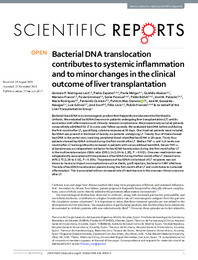Please use this identifier to cite or link to this item:
https://hdl.handle.net/11000/35412Full metadata record
| DC Field | Value | Language |
|---|---|---|
| dc.contributor.author | Rodríguez Laiz, Gonzalo P | - |
| dc.contributor.author | Zapater, Pedro | - |
| dc.contributor.author | Melgar, Paola | - |
| dc.contributor.author | Alcazar Lopez, Candido Fernando | - |
| dc.contributor.author | Franco, Mariano | - |
| dc.contributor.author | Giménez, Paula | - |
| dc.contributor.author | Pascual, Sonia | - |
| dc.contributor.author | BELLOT, PABLO | - |
| dc.contributor.author | Palazón, José M. | - |
| dc.contributor.author | Rodríguez, María | - |
| dc.contributor.author | Carnicer, Fernando | - |
| dc.contributor.author | Más-Serrano, Patricio | - |
| dc.contributor.author | González Navajas, José Manuel | - |
| dc.contributor.author | Gómez, Luis | - |
| dc.contributor.author | Such, José | - |
| dc.contributor.other | Departamentos de la UMH::Farmacología, Pediatría y Química Orgánica | es_ES |
| dc.contributor.other | Departamentos de la UMH::Patología y Cirugía | es_ES |
| dc.date.accessioned | 2025-01-28T18:18:25Z | - |
| dc.date.available | 2025-01-28T18:18:25Z | - |
| dc.date.created | 2019-01-29 | - |
| dc.identifier.citation | Scientific Reports. 2019 Jan 29;9(1):835 | es_ES |
| dc.identifier.issn | 2045-2322 | - |
| dc.identifier.uri | https://hdl.handle.net/11000/35412 | - |
| dc.description.abstract | Bacterial (bact)DNA is an immunogenic product that frequently translocates into the blood in cirrhosis. We evaluated bactDNA clearance in patients undergoing liver transplantation (LT) and its association with inflammation and clinically relevant complications. We prospectively included patients consecutively admitted for LT in a one-year follow-up study. We evaluated bactDNA before and during the first month after LT, quantifying cytokine response at 30 days. One hundred patients were included. BactDNA was present in the blood of twenty-six patients undergoing LT. Twenty-four of these showed bactDNA in the portal vein, matching peripheral blood-identified bactDNA in 18 cases. Thirty-four patients showed bactDNA in blood during the first month after LT. Median TNF-α and IL-6 levels one month after LT were significantly increased in patients with versus without bactDNA. Serum TNF-α at baseline was an independent risk factor for bactDNA translocation during the first month after LT in the multivariate analysis (Odds ratio (OR) 1.14 [1.04 to 1.29], P = 0.015). One-year readmission was independently associated with the presence of bactDNA during the first month after LT (Hazard ratio (HR) 2.75 [1.39 to 5.45], P = 0.004). The presence of bactDNA in the blood of LT recipients was not shown to have any impact on complications such as death, graft rejection, bacterial or CMV infections. The rate of bactDNA translocation persists during the first month after LT and contributes to sustained inflammation. This is associated with an increased rate of readmissions in the one-year clinical outcome after LT. | es_ES |
| dc.format | application/pdf | es_ES |
| dc.format.extent | 12 | es_ES |
| dc.language.iso | eng | es_ES |
| dc.publisher | Springer Nature | es_ES |
| dc.rights | info:eu-repo/semantics/openAccess | es_ES |
| dc.rights.uri | http://creativecommons.org/licenses/by-nc-nd/4.0/ | * |
| dc.title | Bacterial DNA translocation contributes to systemic inflammation and to minor changes in the clinical outcome of liver transplantation | es_ES |
| dc.type | info:eu-repo/semantics/article | es_ES |
| dc.relation.publisherversion | https://doi.org/10.1038/s41598-018-36904-0 | es_ES |

View/Open:
Bacterial DNA translocation contributes to systemic inflammation and to minor changes in the clinical outcome of liver transplantation.pdf
1,68 MB
Adobe PDF
Share:
.png)
